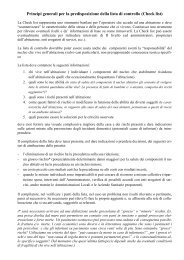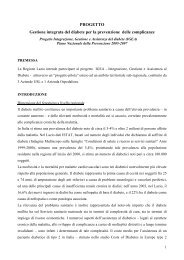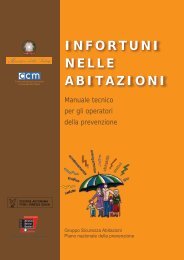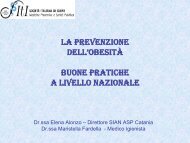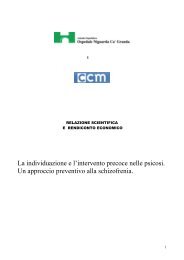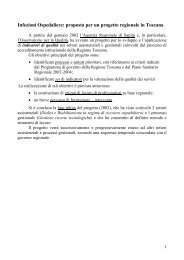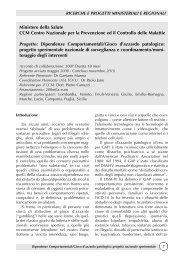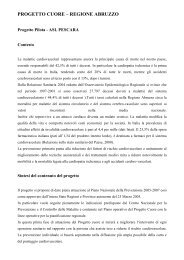Gaining health : analysis of policy development in European ...
Gaining health : analysis of policy development in European ...
Gaining health : analysis of policy development in European ...
You also want an ePaper? Increase the reach of your titles
YUMPU automatically turns print PDFs into web optimized ePapers that Google loves.
Chapter 4<br />
52<br />
2.4.4. National demonstration projects – North Karelia, CINDI,<br />
MONICA<br />
In the 1970s, F<strong>in</strong>nish men had the highest CVD mortality <strong>in</strong><br />
the world. This was particularly serious <strong>in</strong> eastern parts <strong>of</strong><br />
the country, and especially <strong>in</strong> the prov<strong>in</strong>ce <strong>of</strong> North Karelia.<br />
In response to a petition for help signed by a group <strong>of</strong><br />
prov<strong>in</strong>cial representatives, local and national authorities, <strong>in</strong><br />
collaboration with WHO, launched a comprehensive effort<br />
<strong>in</strong> 1972 to tackle CVD morbidity and mortality.<br />
The ma<strong>in</strong> medium-term objectives were to reduce smok<strong>in</strong>g<br />
prevalence and lower cholesterol and blood pressure levels<br />
<strong>in</strong> the whole population, but particularly among middleaged<br />
men. The exist<strong>in</strong>g <strong>health</strong> and social services, together<br />
with government and private authorities, were all expected<br />
to play an active role at local and national levels.<br />
The Project <strong>in</strong>cluded a comprehensive package <strong>of</strong> actions<br />
affect<strong>in</strong>g various sett<strong>in</strong>gs and sectors: legislation on tobacco<br />
control and the production <strong>of</strong> certa<strong>in</strong> foods (such as mix<strong>in</strong>g<br />
oil and butter); regulations concern<strong>in</strong>g smoke-free areas<br />
and <strong>health</strong>ier school lunches; collaboration with manufacturers<br />
and retailers on the production and sale <strong>of</strong> <strong>health</strong>ier<br />
food products (less salt and fat); promotion <strong>of</strong> berry<br />
farm<strong>in</strong>g; broad use <strong>of</strong> the mass media to raise awareness;<br />
<strong>in</strong>volvement <strong>of</strong> community organizations (local politicians<br />
and op<strong>in</strong>ion leaders, the Heart Health Association, women’s<br />
organizations and sports clubs) with special attention to<br />
provid<strong>in</strong>g <strong>health</strong>ier meals at the workplace; and far-reach<strong>in</strong>g<br />
educational efforts through schools and other educational<br />
<strong>in</strong>stitutions.<br />
The changes <strong>in</strong> <strong>health</strong> behaviour and their biological consequences<br />
were quite remarkable, with changes <strong>in</strong> diet play<strong>in</strong>g<br />
a particularly important role (36). The risk factor changes<br />
were followed by a clear fall <strong>in</strong> mortality from coronary<br />
heart disease (37). In the <strong>in</strong>itial pilot project period<br />
1972–1977 only North Karelia was targeted, but given the<br />
<strong>in</strong>terest <strong>of</strong> the mass media, many <strong>of</strong> the Project’s messages<br />
quickly spread throughout the country. After the first ten<br />
years, the scope <strong>of</strong> the project was enlarged to cover other<br />
lifestyle-related chronic diseases and to promote general<br />
<strong>health</strong>. Over a 30-year period, the age-standardized mortality<br />
rate from coronary heart disease for men aged 35–65<br />
years fell by 82% <strong>in</strong> North Karelia and, partly as a result<br />
<strong>of</strong> the demonstration effect <strong>of</strong> the project, by 75% <strong>in</strong> the<br />
whole country, with a similar decrease for women.<br />
The Project cont<strong>in</strong>ues to serve as a national demonstration<br />
project, and local agencies organize not only regional but<br />
also national campaigns such as the National Quit & W<strong>in</strong><br />
campaign <strong>in</strong> 2005, and <strong>development</strong>al work to create local<br />
<strong>health</strong> promotion strategies <strong>in</strong> municipalities. The surveys<br />
<strong>in</strong>itially designed to evaluate the North Karelia project<br />
gradually developed <strong>in</strong>to a national risk factor monitor<strong>in</strong>g<br />
system (FINRISK studies).<br />
Among the <strong>in</strong>terest<strong>in</strong>g characteristics <strong>of</strong> the North Karelia<br />
Project are its systematically developed evidence base; solid<br />
partnerships between national and local government, civil<br />
society and the private sector; the <strong>in</strong>teraction <strong>of</strong> <strong>health</strong><br />
services with other community activities; and the positive<br />
media <strong>in</strong>terest. With<strong>in</strong> these partnerships, there has been a<br />
clear sense <strong>of</strong> government responsibility for <strong>health</strong> promotion,<br />
with civil society play<strong>in</strong>g both a support<strong>in</strong>g but also<br />
a watchdog role and, over the years, the private sector<br />
ga<strong>in</strong><strong>in</strong>g better understand<strong>in</strong>g <strong>of</strong> a <strong>health</strong> promot<strong>in</strong>g bus<strong>in</strong>ess<br />
be<strong>in</strong>g a more susta<strong>in</strong>able bus<strong>in</strong>ess.<br />
Towards the end <strong>of</strong> the 1970s, <strong>in</strong>tense <strong>in</strong>terest <strong>in</strong> population<br />
trends <strong>in</strong> CVD encouraged WHO to br<strong>in</strong>g together <strong>in</strong>vestigators<br />
from a number <strong>of</strong> countries to standardize their<br />
def<strong>in</strong>itions and measurements and comb<strong>in</strong>e their f<strong>in</strong>d<strong>in</strong>gs<br />
(6). This led to the WHO MONICA Project. F<strong>in</strong>land not<br />
only became a member <strong>of</strong> this project, monitor<strong>in</strong>g CVD <strong>in</strong><br />
three regions (North Karelia, Kuopio Prov<strong>in</strong>ce and Turku/<br />
Loimaa), but hosted the MONICA data centre at KTL <strong>in</strong><br />
Hels<strong>in</strong>ki.<br />
Case studies: <strong>policy</strong> <strong>development</strong> <strong>in</strong> countries for tackl<strong>in</strong>g noncommunicable diseases



